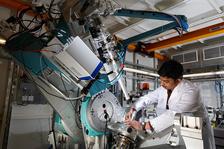Programme A (only at DESY Hamburg)
A1. Solid-state physics and nanoscience (application oriented)
In the field of nanoscience and solid-state physics, students will get hands-on experience in growth of nanostructures (thin films, nanoparticles) by molecular beam epitaxy and sputtering or the preparation of well-defined, ultra-clean
surfaces. In addition they will be introduced to the modern nanoscience approach for the characterization of such nanostructures by combining surface sensitive X-ray diffraction methods with standard surface and nanoscience analytical tools such as scanning electron microscopy, atomic force microscopy and X-ray photoelectron spectroscopy for chemical characterization. In more theoretical projects an introduction to diffraction data analysis concepts for nanostructures and interfaces is offered.
A2. Molecular sciences (application oriented)
Students join groups performing research in chemistry, biology and physics aiming at unraveling the structure-function relationship of molecular sciences. Experiments include the imaging of molecular structure and dynamics of systems ranging from small molecules over nano-objects to biological macromolecules, viruses or cells. These experiments push limits of spatial and temporal resolution using novel X-ray, electron, or ultrashort-laser-pulse sources. Projects include sample preparation, imaging experiments, and data analysis.
A3. Soft-matter sciences (application oriented)
Summer students will learn about modern methods to investigate the structure and dynamics of soft matter systems such as complex liquids and glasses. The students will be introduced into small angle X-ray scattering (SAXS) using coherent X-ray beams, X-ray photon correlation spectroscopy (XPCS), and X-ray cross-correlation analysis (XCCA). In addition, they will be taught how to synthesize colloidal samples in our chemistry lab. Hands on experiments can be performed using laser scattering set-ups to practice the learnt methods on self-synthesized colloidal systems. Analyzing and interpreting the obtained data allows both to train their programming skills as well as the critical discussion of experimental results.
A4. Development of experimental techniques (methodology oriented)
Students join groups developing new experimental techniques in the field of photon science, including diffraction and scattering, spectroscopy, and imaging. X-rays have unique properties to probe matter on all length scales down to the atomic level. The large penetration depth gives access to the bulk of a sample, and allows the investigation of a specimen inside special sample environments, such as chemical reactors or pressure cells. Topics include ultrafast, time-resolved or in-situ diffraction and scattering techniques, imaging and microscopy with coherent X-rays, tomography, X-ray optics and nanofocusing, scanning microscopy and microspectroscopy.
A5. Lasers and optics (methodology oriented)
Students join groups in developing laser sources, measurement and diagnostics techniques and their applications. Topics are ultrafast lasers, high power and high energy lasers, fiber and waveguide lasers, optical parametric chirped pulse amplifiers, optical pump- XUV probe experiments, free-electron laser (FEL) seeding, strong field optical sub-cycle pulse synthesis, mid-infrared sources, frequency combs and phase stable laser sources, laser spectroscopy, dielectric accelerators, low emittance photoelectron generation, strong field THz pulses for time resolved studies, X-ray pulse diagnostics and compact THz accelerators, high order harmonic generation and attosecond science, ultrafast nano-optics, and compact X-ray sources. Projects include laser optics, optomechanics, electronics and programming, simulations and data analysis.
A6. Theory and computing
Theory problems addressed in photon science generally have a close connection to experimental applications or to the development of new methodologies for characterizing the properties of matter. Most problems of interest require an intense use of numerical techniques, but also a solid understanding of the underlying theory. Projects for summer students include work on solving the Schrödinger equation for highly excited many-electron systems; solving the time-dependent Schrödinger equation for the description of dynamical processes; techniques for nonperturbative radiation-matter interactions; quantum-chemical simulations; and the development of algorithms for solving mathematical problems specific to photon science and imaging science.

Loading menu, please wait..
Deutsches Elektronen-Synchrotron DESY
A Research Centre of the Helmholtz Association
✖

Loading menu, please wait..

Loading menu, please wait..





